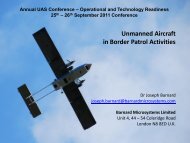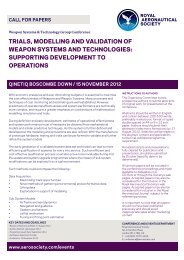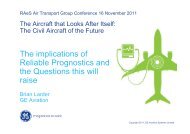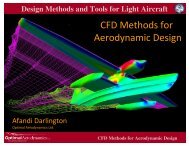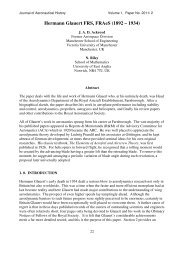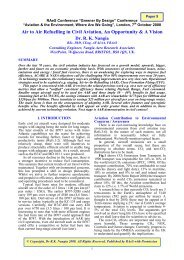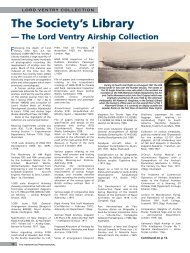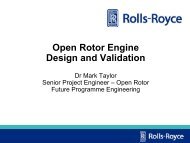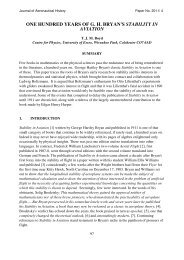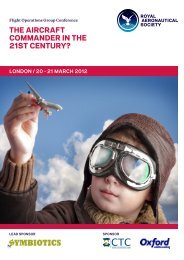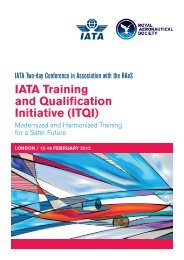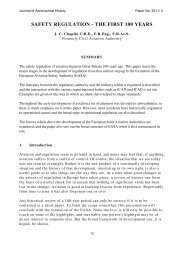Smoke, Fire and Fumes in Transport Aircraft - Royal Aeronautical ...
Smoke, Fire and Fumes in Transport Aircraft - Royal Aeronautical ...
Smoke, Fire and Fumes in Transport Aircraft - Royal Aeronautical ...
Create successful ePaper yourself
Turn your PDF publications into a flip-book with our unique Google optimized e-Paper software.
5. It is felt that the duration (endurance) of the Essential only selection should be greater than it now is <strong>and</strong> should reflect the type of<br />
operation that the aircraft is designed for. A possible solution is discussed under the next head<strong>in</strong>g.<br />
Essential Battery Bus Supply<br />
The majority of electrical systems <strong>in</strong> modern aircraft give an absolute maximum of 30 m<strong>in</strong>utes battery-only electrical power. While this may<br />
meet the majority of requirements on overl<strong>and</strong> flight operations, <strong>in</strong> the case of a diversion <strong>in</strong>volv<strong>in</strong>g smoke <strong>and</strong> fire where the smoke or fire<br />
can be controlled, this battery power may be <strong>in</strong>sufficient to allow a safe diversion <strong>and</strong> l<strong>and</strong><strong>in</strong>g.<br />
In consequence, very serious consideration should be given to the provision of a supplementary charg<strong>in</strong>g facility to top-up the battery <strong>in</strong> orig<strong>in</strong>al<br />
manufacturer designs or as a retro-fit requirement, such as an extendable/retractable Ram Air Turb<strong>in</strong>e (RAT). The aim is to extend the battery<br />
power-supply endurance <strong>in</strong>def<strong>in</strong>itely, thus beyond the present thirty m<strong>in</strong>utes battery-life capability to feed the Essential Instruments Bus after<br />
all electrical power has been removed from aircraft systems, when deal<strong>in</strong>g with electrical fires <strong>and</strong> smoke sources on the way to l<strong>and</strong><strong>in</strong>g the<br />
aircraft.<br />
The rationale beh<strong>in</strong>d a need for a retractable RAT is that if normal supplies can be partly restored <strong>and</strong> the flight then completed at normal<br />
cruise speeds, the RAT could then be retracted so as not to damage it or produce unnecessary drag.<br />
<strong>Fire</strong> Detection<br />
Because crews do not have a secondary system to confirm <strong>Fire</strong> <strong>and</strong> <strong>Smoke</strong> warn<strong>in</strong>gs, there have been many false Cargo hold fire warn<strong>in</strong>gs<br />
<strong>in</strong> recent years, with resultant unnecessary diversions <strong>and</strong> passenger <strong>in</strong>juries from evacuation. As a parallel, an eng<strong>in</strong>e is not shut-down based<br />
on a s<strong>in</strong>gle gauge abnormal <strong>in</strong>dication, yet a s<strong>in</strong>gle detection loop warn<strong>in</strong>g is accepted for cargo holds. Credence <strong>in</strong> the fire <strong>and</strong> smoke<br />
detection systems will dim<strong>in</strong>ish if false alarms cont<strong>in</strong>ue. Then, one day, a real fire warn<strong>in</strong>g will be ignored with catastrophic results.<br />
To guard aga<strong>in</strong>st this happen<strong>in</strong>g, it is recommended that provision be made dur<strong>in</strong>g manufacture, or <strong>in</strong>deed retrospectively, for cargo holds to<br />
have dual detection systems based on complementary technologies so that one system detects smoke <strong>and</strong> the other heat or flame. This will<br />
allow greater confidence <strong>in</strong> mak<strong>in</strong>g a dist<strong>in</strong>ction between genu<strong>in</strong>e <strong>and</strong> false warn<strong>in</strong>gs <strong>and</strong> so avoid unnecessary diversions.<br />
In addition, visual <strong>in</strong>spection panels should be placed above holds that are <strong>in</strong>accessible <strong>in</strong> flight. On wide-bodied aircraft, there should be at<br />
least one such view<strong>in</strong>g w<strong>in</strong>dow appropriately fitted <strong>in</strong> each aisle. Better still, a panel that can be opened to view <strong>and</strong> ascerta<strong>in</strong> whether ‘<strong>Smoke</strong>’<br />
or ‘Mist’ has triggered the fire detector, could usefully assist human noses <strong>and</strong> eyes to confirm a warn<strong>in</strong>g, or otherwise.<br />
Airframe Thermal Sensors<br />
Remote thermal <strong>and</strong> smoke sensors should also be <strong>in</strong>stalled <strong>in</strong> all the <strong>in</strong>accessible areas of the aircraft <strong>and</strong> areas which cannot be seen beh<strong>in</strong>d<br />
the pressurised cab<strong>in</strong> wall l<strong>in</strong>ers or outside pressurised areas, to provide a fire warn<strong>in</strong>g where no protective sens<strong>in</strong>g now exits. Facilities for<br />
visual <strong>in</strong>spections from with<strong>in</strong> the pressurised cab<strong>in</strong> could be made available to advantage.<br />
SAFETY EQUIPMENT AND PROCEDURES (SEP) TRAINING<br />
Cab<strong>in</strong> crewmembers should be regularly rem<strong>in</strong>ded that all unusual occurrences should always be reported to the flight deck crew <strong>and</strong> that no<br />
one should ever assume that the pilots are aware of what is go<strong>in</strong>g on beh<strong>in</strong>d their closed door. The Kegworth accident might have never<br />
happened if the Capta<strong>in</strong> had been told that the left eng<strong>in</strong>e was on fire as noted from the cab<strong>in</strong> but not reported to him by the cab<strong>in</strong> crew. The<br />
capta<strong>in</strong> shut-down the right-h<strong>and</strong> eng<strong>in</strong>e on the wrong assumption that it was the cause of the air system smoke he was experienc<strong>in</strong>g <strong>in</strong> the<br />
cockpit. He was never told dur<strong>in</strong>g a recent variant upgrade technical conversion course that, on the mark of B737 he was now fly<strong>in</strong>g, cockpit<br />
air was supplied from both eng<strong>in</strong>es. The left eng<strong>in</strong>e dis<strong>in</strong>tegrated soon after <strong>and</strong> the aircraft crashed short of the airfield, at night <strong>and</strong> with no<br />
eng<strong>in</strong>es runn<strong>in</strong>g, due to this avoidable breakdown <strong>in</strong> communications.<br />
The change from hybrid electro-mechanical <strong>in</strong>struments to LED displays for eng<strong>in</strong>e <strong>in</strong>dications had reduced conspicuity, particularly <strong>in</strong> respect<br />
of the eng<strong>in</strong>e vibration <strong>in</strong>dicators. No additional vibration alert<strong>in</strong>g system was fitted that could have highlighted to the pilots which of the two<br />
eng<strong>in</strong>es was vibrat<strong>in</strong>g excessively, which did not help. Although the cause of the accident was the shutt<strong>in</strong>g down of the wrong eng<strong>in</strong>e, had the<br />
cab<strong>in</strong> crew made the pilots aware of what they had seen, the serviceable eng<strong>in</strong>e might have been restarted <strong>in</strong> time to avoid an accident that<br />
raises many questions, not the least of which is tra<strong>in</strong><strong>in</strong>g.<br />
THE QUICK REFERENCE MANUAL (QRM)<br />
Normal Operations <strong>and</strong> Quick Reference Manual checklists <strong>and</strong> drills are produced by the <strong>Aircraft</strong> Manufacturer. It is the manufacturer’s<br />
responsibility to ensure they rema<strong>in</strong> up-to-date <strong>in</strong> the light of experience from both normal flight operations <strong>and</strong> by us<strong>in</strong>g feedback from<br />
<strong>in</strong>cidents or accidents. Operators cannot change anyth<strong>in</strong>g with<strong>in</strong> them without the total agreement of the Manufacturer <strong>and</strong> the express<br />
permission of the Certify<strong>in</strong>g Regulatory Authority.<br />
Both QRM <strong>and</strong> Normal operations drills do not <strong>in</strong>clude such sundry items as select<strong>in</strong>g Fasten Seat Belts or No Smok<strong>in</strong>g signs to ON or OFF<br />
for example. Such entries are for the operator to place at a suitable po<strong>in</strong>t <strong>in</strong> the checklist, to satisfy the <strong>in</strong>-house St<strong>and</strong>ard Operat<strong>in</strong>g Procedure<br />
(SOP). Before an Operator can change a published sequence, the Manufacturer needs to amend the <strong>Aircraft</strong> Flight Manual with the Approval<br />
of the Regulatory Authority.<br />
Us<strong>in</strong>g an old but good set of now out-of-date manuals for illustration as pictured below, ‘Normal’ checklists could be usefully pr<strong>in</strong>ted <strong>in</strong> a Black<br />
sans-serif font on white card, to differentiate them from Quick Reference Manual (QRM) pages with Emergency <strong>and</strong> Abnormal drills that are<br />
FEBRUARY 2007 37



